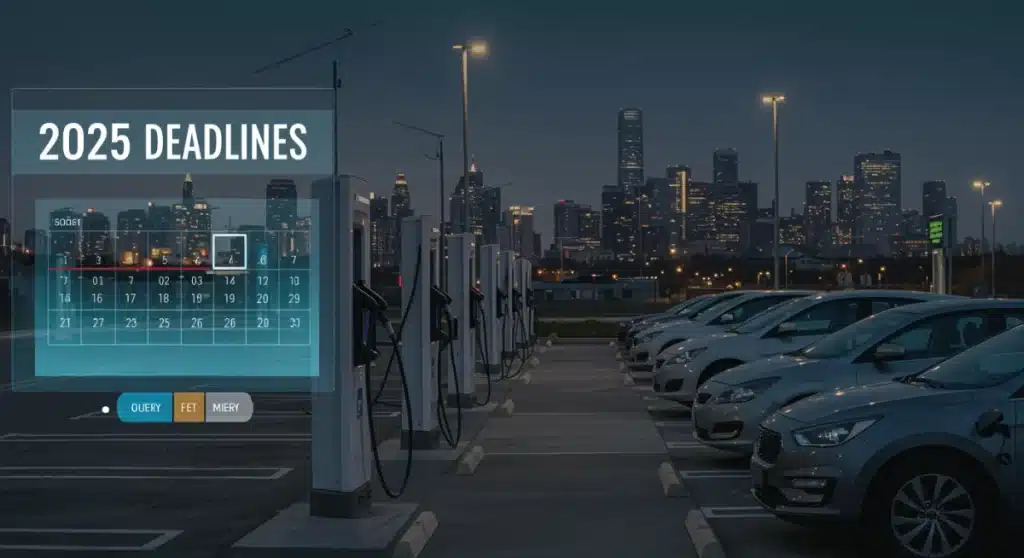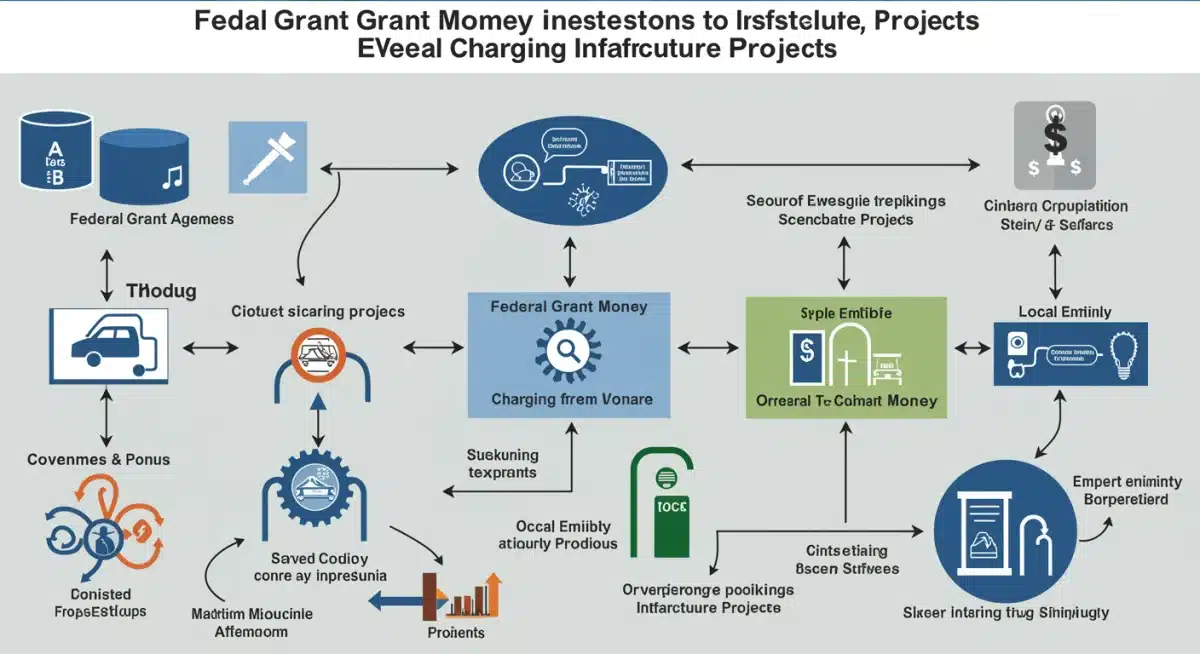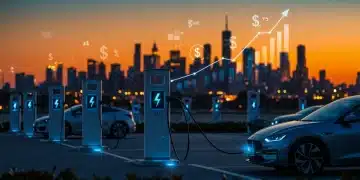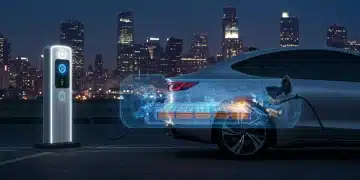Critical 2025 Deadlines for EV Infrastructure Grants: Don’t Miss Out

Critical 2025 Deadlines for EV Infrastructure Grants are fast approaching, offering millions in funding for charging station development across the nation, demanding immediate action from prospective applicants.
The clock is ticking for securing vital funding. Critical 2025 Deadlines for EV Infrastructure Grants: Don’t Miss Out on Millions in Funding (TIME-SENSITIVE) are rapidly approaching, presenting a pivotal moment for states, municipalities, and private entities to accelerate electric vehicle charging infrastructure deployment.
The Urgency of Upcoming 2025 EV Grant Deadlines
The landscape of electric vehicle adoption continues its rapid expansion, creating an urgent demand for robust charging infrastructure. Federal and state governments have allocated billions to support this transition, but these funds come with strict application windows. Missing these critical 2025 deadlines could mean foregoing substantial financial assistance essential for crucial projects.
According to recent reports from the Department of Energy, the pace of EV sales has outstripped the deployment of public charging stations in several key regions. This disparity highlights the immediate need for aggressive infrastructure development, making the current grant opportunities more critical than ever before. Stakeholders must act decisively to capitalize on these limited-time offers.
Federal Funding Initiatives for EV Charging
Several significant federal programs are at the forefront of this funding push. The Bipartisan Infrastructure Law (BIL), enacted in 2021, established the National Electric Vehicle Infrastructure (NEVI) Formula Program, which alone allocates $5 billion over five years to states to build out a national EV charging network. This program prioritizes charging along designated Alternative Fuel Corridors, ensuring strategic deployment.
- NEVI Formula Program: Focuses on state-led deployment along major corridors.
- Charging and Fueling Infrastructure (CFI) Discretionary Grant Program: Supports community and corridor charging, including rural areas and disadvantaged communities.
- Clean School Bus Program: Provides funding for electric school buses and associated charging infrastructure.
These programs represent a multi-faceted approach to addressing charging needs, from long-haul travel to local community access. Understanding the specific requirements and timelines for each is paramount for successful grant applications.
Decoding the NEVI Formula Program: Key Requirements and Timelines
The NEVI Formula Program stands as a cornerstone of the federal strategy to build a national EV charging network. States must submit annual plans detailing how they intend to use their allocated funds, with specific deadlines that impact project timelines. These plans are reviewed and approved by the Joint Office of Energy and Transportation.
For 2025, states are refining their implementation strategies, focusing on meeting the stringent technical requirements set forth by the program. These include charger types, payment interoperability, and uptime reliability standards. Adherence to these specifications is not optional; it is fundamental to receiving and retaining NEVI funds.
Technical Specifications and Interoperability
NEVI-funded charging stations must meet specific technical standards to ensure a seamless and reliable experience for all EV drivers. These standards are designed to prevent fragmentation in the charging network and promote widespread accessibility.
- DC Fast Chargers: Must have a minimum power level of 150 kW per port.
- Combined Charging System (CCS) connectors: Required for all ports, with provisions for other connector types as technology evolves.
- Payment Interoperability: Stations must accept credit cards and contactless payment options.
- 97% Uptime Reliability: A critical operational metric ensuring chargers are consistently functional.
The deadlines for submitting updated state plans and project proposals for 2025 are typically in late summer or early fall of the preceding year. This means that many states are already deep into planning and procurement phases for projects that will be funded in the upcoming fiscal year. Proactive engagement with state DOTs and energy offices is essential for potential applicants.
The Charging and Fueling Infrastructure (CFI) Discretionary Grant Program
Beyond NEVI, the CFI Discretionary Grant Program offers another significant avenue for funding EV infrastructure. This program is designed to fill gaps and address specific needs not fully covered by the NEVI formula funds, particularly in community-based charging and alternative fuel corridors not designated under NEVI.
The CFI program is highly competitive, requiring robust applications that demonstrate clear community benefit, project viability, and alignment with federal clean energy goals. Recent solicitations have emphasized projects that serve disadvantaged communities, improve air quality, and create good-paying jobs. The application window for CFI grants typically opens annually, often in the spring, with deadlines in late summer.
Targeted Funding for Community and Rural Access
A key differentiator for the CFI program is its flexibility to support a wider range of charging locations. This includes charging at multi-family housing, workplaces, public facilities, and in rural areas where charging options are often scarce. The program aims to ensure that the benefits of EV adoption are accessible to all segments of the population.
- Community Charging: Supports charging in urban and suburban areas, including residential and commercial zones.
- Rural Charging: Prioritizes projects in underserved rural communities to expand access.
- Alternative Fuel Corridors (Non-NEVI): Funds charging along corridors not covered by the NEVI program.
Applicants for CFI grants must meticulously prepare their proposals, detailing project scope, budget, timeline, and expected outcomes. Emphasis is placed on projects that can demonstrate strong partnerships with local governments, utilities, and private sector entities, showcasing a collaborative approach to infrastructure development.

State-Specific Deadlines and Complementary Programs
While federal programs provide a substantial foundation, many states have introduced their own complementary grant programs and incentives to accelerate EV infrastructure deployment. These state-level initiatives often have unique criteria, funding amounts, and, critically, their own set of deadlines. These can range from rebate programs for charging equipment to grants for utility infrastructure upgrades.
It is imperative for potential applicants to monitor both federal and state announcements closely. Information on state programs is typically disseminated through state energy offices, environmental protection agencies, and public utility commissions. Aligning projects with both federal and state priorities can significantly increase the likelihood of securing funding.
Navigating State-Specific Application Processes
Each state’s application process can vary widely, from online portals to detailed written proposals. Some states offer technical assistance to guide applicants through the process, recognizing the complexity involved. Early engagement with state program managers can provide invaluable insights and support.
- State Energy Offices: Primary source for information on state-specific EV grant programs.
- Public Utility Commissions: Often manage incentives for utility upgrades supporting EV charging.
- Local Government Initiatives: Some cities and counties offer their own micro-grant programs.
Many state programs are designed to leverage or match federal funds, maximizing the impact of every dollar invested. This layered funding approach is crucial for building out a comprehensive and resilient charging network. Understanding the interplay between federal and state funding streams is a strategic advantage for applicants.
Strategic Planning for Successful Grant Applications
Securing EV infrastructure grants, especially with the looming 2025 deadlines, requires meticulous planning and a strategic approach. It’s not just about identifying the right grant; it’s about crafting a compelling proposal that stands out. This involves a clear understanding of project costs, anticipated benefits, community impact, and long-term sustainability.
Applicants should begin by conducting a thorough needs assessment to identify optimal locations for charging stations and the specific types of chargers required. This data-driven approach strengthens the argument for funding and demonstrates a well-thought-out plan. Engaging with local stakeholders, including businesses, community groups, and utility providers, can also bolster an application.
Key Elements of a Winning Proposal
A strong grant application typically includes several core components that address the funder’s objectives and demonstrate project readiness. Attention to detail in each of these areas is critical for success.
- Detailed Project Description: Clearly outline the project scope, objectives, and expected outcomes.
- Comprehensive Budget: Provide a realistic and itemized budget, including all anticipated costs.
- Feasibility Study: Demonstrate the technical and financial viability of the proposed project.
- Community Benefits: Highlight how the project will serve the public good, particularly disadvantaged communities.
- Sustainability Plan: Explain how the charging infrastructure will be maintained and operated long-term.
Furthermore, demonstrating a clear understanding of federal and state priorities, such as equity, environmental justice, and economic development, can significantly enhance an application’s appeal. Proposals that align with these broader goals are often viewed more favorably by grant reviewers.
The Role of Partnerships and Collaboration in Grant Success
The complexity and scale of deploying EV charging infrastructure often necessitate collaboration across various sectors. Partnerships between public entities, private businesses, utilities, and community organizations can significantly strengthen grant applications and improve project outcomes. These collaborations bring diverse expertise, resources, and perspectives to the table, addressing challenges more effectively.
For example, a municipality partnering with a local utility can streamline the grid connection process for new charging stations, while a collaboration with a private charging network operator can leverage existing technology and operational expertise. Grant programs frequently look for evidence of strong, committed partnerships as an indicator of project viability and sustainability.
Building Effective Coalitions for EV Deployment
Establishing robust partnerships early in the planning phase is crucial. This involves identifying potential collaborators whose goals align with the proposed project and who can contribute meaningfully to its success. Formalizing these partnerships through memoranda of understanding or letters of commitment can add significant weight to a grant application.
- Public-Private Partnerships: Combine public funding with private sector innovation and efficiency.
- Utility Engagement: Essential for grid upgrades and power supply to charging sites.
- Community Organizations: Ensure projects meet local needs and promote equitable access.
- Academic Institutions: Can provide research, data analysis, and technical expertise.
Successful collaboration not only enhances the chances of securing grants but also ensures that the deployed infrastructure is well-integrated, efficiently operated, and serves the needs of the community effectively. The synergistic effects of strong partnerships can lead to more impactful and sustainable EV charging solutions, contributing to the broader goal of accelerating electric vehicle adoption nationwide.
| Key Point | Brief Description |
|---|---|
| 2025 Grant Deadlines | Critical application periods for federal and state EV infrastructure funding are rapidly approaching. |
| NEVI Program | $5 billion federal initiative for state-led EV charging network deployment along key corridors. |
| CFI Grant Program | Discretionary grants supporting community and rural EV charging, filling gaps not covered by NEVI. |
| Strategic Planning | Meticulous project planning, strong partnerships, and adherence to technical standards are vital for success. |
Frequently Asked Questions About EV Infrastructure Grants
The main federal programs are the National Electric Vehicle Infrastructure (NEVI) Formula Program and the Charging and Fueling Infrastructure (CFI) Discretionary Grant Program. NEVI focuses on highway corridors, while CFI supports community and rural charging initiatives to expand access.
The 2025 deadlines are crucial because they represent the current application windows for significant federal and state funding cycles. Missing these deadlines means delaying projects and potentially losing out on millions of dollars essential for expanding necessary EV charging infrastructure.
NEVI-funded stations require DC fast chargers with at least 150 kW per port, CCS connectors, credit card/contactless payment options, and a minimum 97% uptime reliability. These standards ensure a consistent and reliable user experience across the national network.
Information on federal grants is available via the Joint Office of Energy and Transportation and Grants.gov. For state-specific programs, contact your state energy office, environmental protection agency, or public utility commission. Early and continuous monitoring is advised.
Partnerships are vital. Collaborations between public entities, private businesses, and utilities strengthen grant applications by pooling resources, expertise, and demonstrating project viability. Grant programs often prioritize proposals that showcase strong, committed multi-sectoral partnerships for broader impact.
What Happens Next
As the electric vehicle market continues its exponential growth, the pressure to build out a robust, accessible, and reliable charging infrastructure intensifies. The upcoming 2025 deadlines for EV infrastructure grants represent a critical juncture for accelerating this development. Stakeholders who prioritize strategic planning, meticulous application preparation, and robust partnerships will be best positioned to harness these unprecedented funding opportunities. The coming months will see a scramble for these funds, shaping the future of EV adoption and energy independence across the nation.





